Beth Kephart's Blog, page 52
April 7, 2015
On Nova Ren Suma and the power of vivid
 I bought Nova Ren Suma's The Walls Around Us strictly on the power of the word-of-mouth roar this writer has accumulated over the years. Didn't read a single review. Didn't read the jacket copy. Did (confession) read the persuasive Publishers Weekly interview, but that was just for edifying fun, for my mind had already been made up.
I bought Nova Ren Suma's The Walls Around Us strictly on the power of the word-of-mouth roar this writer has accumulated over the years. Didn't read a single review. Didn't read the jacket copy. Did (confession) read the persuasive Publishers Weekly interview, but that was just for edifying fun, for my mind had already been made up.What kind of writer is the kind of writer that other writers gush about?
What kind of writer reminds other writers of the need (importance, glory) of writing away from commercial expectations and toward one's own heart? Saying,
The Walls Around Us was a book written solely and unapologetically for me. I allowed myself to be as weird and wild as I wanted. I did not hold back. I stopped trying to write to what I thought an audience or a publisher might want from me. It was freeing and exhilarating. And the outcome – what this book has become, and the reaction it’s gotten out in the world so far – completely surprised me. I learned a lot from this process: I should probably stop worrying so much about what everyone else thinks of me more often.
What kind of writer? Nova Ren Suma. (Words above from the PW interview)
I opened the book. I read the first page. What the bleeping heck, I thought. What the wondrous heck. This Suma is a writer, just like everybody said.
First sentences.
We went wild that hot night. We howled, we raged, we screamed. We were girls—some of us fourteen and fifteen; some sixteen, seventeen—but when the locks came undone, the doors of our cells gaping open and no one to shove us back in, we made the noise of savage animals, of men.Sometimes a writer will take her foot of the gas after the first stellar page or two, then just lay out, in ordinary fashion, the plot, the themes, the (I am sorry to have to use this word) message. Not Suma. Her exaltation of and in language can be found on this book's every page. Her willingness to risk. Here she is, for example, describing an attempted escape from the juvenile detention center where much of this supernatural story takes place. There's a storm going on out there. There's a girl trying to get away.
I caught the rest in flashes. It wasn't that I couldn't focus; it was the lightning, the summer storm raging through the window. She'd be dark, and then she'd go bright. Her yellow hair black, her yellow hair white. I caught her, foot kicking out and the perfect hit in the center of the glass that caved in. Then came the second and third kicks that made it shatter. She'd gouged open the window into the night.I'm going to call that urgent pattering. I'm going to say I felt the night blow through.
And how about this:
I have this distant memory, hanging on a ratty clothesline in the backyard of my mind, and in this memory, I am running. There I am, running fast and hard for that window as if it's a set of doors that will soon be slamming closed to passengers and I'll lose my chance. I will lose at all chances forever. That feels real enough.The ratty clothesline in the backyard of my mind. Damn, Suma. Damn.
I am not in the habit of reading supernatural paranormal whatever it is that critics might be calling The Walls Around Us. I cannot tell you where this book falls within the canon. I can only say please count me in to the rapidly growing Nova Ren Suma fan club. She tossed conventional expectations aside. She wrote for herself. She had fun. She was not locked into The Ideas Others Have About What Makes for YA Fame and Glory. And look at what she made—and how the world is responding.
We need, we want, we celebrate the new. Think less of what others think of you.




Published on April 07, 2015 04:52
April 6, 2015
traveling far to write close (in the abrams and chronicle blog)
 Over the course of the past several days, my Twitter feed has bloomed with posts from the good people of Abrams & Chronicle. Chosen lines from One Thing Stolen, posterized. Words of encouragement and hope. It's been a quiet, miraculous thing. This sense this UK publishing arm has provided of a story fully seen.
Over the course of the past several days, my Twitter feed has bloomed with posts from the good people of Abrams & Chronicle. Chosen lines from One Thing Stolen, posterized. Words of encouragement and hope. It's been a quiet, miraculous thing. This sense this UK publishing arm has provided of a story fully seen.And so, when Abrams & Chronicle (through Lara Starr) asked me to write about how my travels have influenced my stories, I was more than happy to comply, writing the story that appears today, here. Please take some time to review the many lovely posts on A&C blog. I promise you good reads and eats.
But while I'm at this, I'd like to thank my dear friend Ed Goldberg, who has been such an exquisite companion through my many seasons as a writer of books for young adult readers. I was standing in the lobby of an Atlantic City hotel years and books ago when I first received an Ed email. I was standing in Books of Wonder when I first (a surprise) met him. And here he is again, reading One Thing Stolen and offering his support in his beautiful blog, Two Heads Together. I am forever grateful.




Published on April 06, 2015 05:33
April 2, 2015
above all else, these things I seek

 I went away to celebrate my birthday—up the Delaware River, on the New Jersey side, in the town made famous by Elizabeth Gilbert. I wore funky boots and worried about nothing and bought the coolest felt coat for close to nothing, gifts for a friend, a brass feather for my hair. Walking and walking beside my husband, who had surprised me with Frenchtown, who understood my deep need to be elsewhere.
I went away to celebrate my birthday—up the Delaware River, on the New Jersey side, in the town made famous by Elizabeth Gilbert. I wore funky boots and worried about nothing and bought the coolest felt coat for close to nothing, gifts for a friend, a brass feather for my hair. Walking and walking beside my husband, who had surprised me with Frenchtown, who understood my deep need to be elsewhere.These few things, while I was gone:
One Thing Stolen was named an April Editor's Pick by Amazon and a Top 14 YA April book by Bustle. I am grateful and humbled.
Galleys for Love: A Philadelphia Affair arrived. This book becoming a real thing, then. More gratitude.
The German edition of You Are My Only showed up in a white box. It is always deeply interesting to see a story remade in another language, announced to the world with a new image. I'm grateful for Hanser's faith in the novel.
I had many thoughts while I was away about what really matters, what makes me happiest. Family. Friendship. Time. Peace. These things I seek, above all else. You can make something special without spending lots of money. You can say love without wrapping it in a bow. You can look ahead and worry less. I keep getting better at that. Family. Friendship. Time. Peace.
Familyfriendshiptime.
Peace.




Published on April 02, 2015 10:12
April 1, 2015
Thoughts on I Refuse (Per Petterson) in today's New York Journal of Books
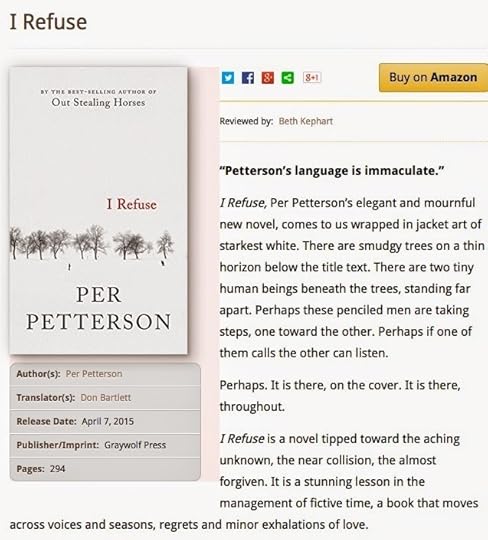 Readers of this blog know just how much I love Per Petterson. Indeed, having read all of his books I can say with some assurance that I Refuse, his newest, is his most technically astonishing and emotionally devastating.
Readers of this blog know just how much I love Per Petterson. Indeed, having read all of his books I can say with some assurance that I Refuse, his newest, is his most technically astonishing and emotionally devastating.My thoughts can be found here, in the New York Journal of Books.




Published on April 01, 2015 04:08
March 31, 2015
when diversity is not a strategy but an essential element of the story being told: Blue Birds by Caroline Starr Rose
 We Need Diverse Books. We absolutely do. Books that don't merely place a "non-mainstream" character into the story for the sake of inclusion. Books that go much deeper than the announcement of, or allusion to, skin color, origin countries, sexual preferences. Books that don't operate as if conforming to PC checklists. Books that function outside the circle of slogans and tell real stories.
We Need Diverse Books. We absolutely do. Books that don't merely place a "non-mainstream" character into the story for the sake of inclusion. Books that go much deeper than the announcement of, or allusion to, skin color, origin countries, sexual preferences. Books that don't operate as if conforming to PC checklists. Books that function outside the circle of slogans and tell real stories.Truly diverse books are books in which the culture and cultural heritage and economics of the characters are essential to the story being told. They explore wide ranging personages, languages, histories, orientations, dreams. They are steeped in the particular social and personal pressures faced by very particular (and particularly well-drawn) characters. They introduce characters that seem to live not just on the page, but off it.
Middle grade/YA novels such as Ann E. Burg's Serafina's Promise, Thanhha Lai's Inside Out and Back Again, Jacqueline Woodson's Brown Girl Dreaming, Kwame Alexander's Crossover, A.S. King's Ask the Passengers , and Patricia McCormick's Never Fall Down and Sold have, among many other titles, introduced lasting, fully dimensional, diverse characters to younger readers. With her second stunning middle grade novel, Blue Birds, Caroline Starr Rose has made another important addition to this canon.
Blue Birds is a novel in verse that explores a little-known chapter of American history concerning the "Lost Colony" of Roanoke. It's late in the 16th century. English explorers have arrived to Roanoke Island, off Virginia. Conflict and distrust erupt among the native tribes and the English.
Into this setting Rose has placed two young girls—Alis, from England, and Kimi, a Roanoke who has watched the English bring disease and disaster to her world. Out on her own, Alis discovers the natural beauty of the place. Watching, Kimi must decide whether or not to trust this fair-skinned creature. Will Alis and Kimi be able to peel back the social prejudice and befriend one another? Will they be able to step over the great divide that rises whenever individual people are presented with difference? And what will they do—what can they do—as tensions mount in their respective communities?
Rose has given us a complex story, a real and researched story, a story that, despite its roots in late 16th century America, feels contemporary. The questions about other are neither dodged nor trumped, and they never feel commercially strategic. The questions arise because such questions naturally do, because this is the story Starr is telling. And look how gracefully and honestly she tells it:
Why do they dress as they do?In bringing readers Alis and Kimi, Starr has not just brought us a distant era. She's brought her readers a way of sinking in with real questions about difference—and a credible suggestion that such differences might be overcome.
To speak their language,
does it feel as it sounds,
like sharpened rocks on your tongue?
What makes their skin
the color of a snake's underside?
Why do the men not keep their faces smooth
but grow hair from their cheeks?
Do they ever bathe?
For their strong odor lingers
long after they've gone.
Though they
have brought us heartache,
must all of them
be enemies?




Published on March 31, 2015 06:05
March 30, 2015
Writing about Mental Health, One Thing Stolen, and New Hope for Frontotemporal Dementia
 Tomorrow evening I'll be down at Penn, at Kelly Writers House, participating in a 7-Up program that promises to be provocative. The theme is mental health and literature. The evening, a Junior Fellows Program, was knit together (so ably) by Hannah White. You can find more about the evening below, and of course you are welcome to come.
Tomorrow evening I'll be down at Penn, at Kelly Writers House, participating in a 7-Up program that promises to be provocative. The theme is mental health and literature. The evening, a Junior Fellows Program, was knit together (so ably) by Hannah White. You can find more about the evening below, and of course you are welcome to come.In trying to develop a presentation that fits within the given seven minute boundaries, I'm aware of all that I won't have time to say about the medical research and stories that have been released in the months after I finished writing One Thing Stolen, a novel that has a rare neurodegenerative condition—frontotemporal dementia, primary progressive aphasia—at its heart.
(Generally speaking, FTD is a category of conditions brought on by the "progressive degeneration of the temporal and frontal lobes of the brain." Some patients afflicted with the "language subtypes" of FTD erupt with new artistic capabilities—a sign, it is thought, of a brain attempting to compensate for those parts of the brain that are no longer working as they once were.)
I would like, then, to summarize four key stories here—stories that validate the hope that readers will find in the final pages of Nadia's story.
In writing One Thing Stolen, I grounded my hope in the work of (and email conversations with) Bruce Miller, MD, who directs the UCSF Memory and Aging Center and whose work on FTD "emphasizes both the behavioral and emotional deficits that characterize these patients, while simultaneously noting the visual creativity that can emerge in the setting of FTD."
But in my novel, Penn doctors are at work as well, and just days ago, on March 20, Penn Medicine researchers announced, and here I'm quoting from the press release, the discovery that " hypermethylation - the epigenetic ability to turn down or turn off a bad gene implicated in 10 to 30 percent of patients with Amyotrophic Lateral Sclerosis (ALS) and Frontotemporal Degeneration (FTD) - serves as a protective barrier inhibiting the development of these diseases. Their work, published this month in Neurology, may suggest a neuroprotective target for drug discovery efforts."
Later on in the release, this quote from Corey McMillan, PhD, research assistant professor of Neurology in the Frontotemporal Degeneration Center in the Perelman School of Medicine at the University of Pennsylvania: "We believe that this work provides additional data supporting the notion that C9orf72 methylation is neuroprotective and therefore opens up the exciting possibility of a new avenue for precision medicine treatments and targets for drug development in neurodegenerative disease,” says McMillan.
So all of that is number 1. Hope, again.
For number 2, I encourage you to read this deeply moving essay by Daniel Zalewski in the March 30 issue of The New Yorker. Titled "Life Lines," it traces the journey of a former New Yorker illustrator whose brain, attacked by a virus, now lives in the ever-present now, most of her hippocampus destroyed. Researchers are studying her ability to learn and form memories within this new neuronal environment. There is hope there. There is also the prospect of new science.
Finally, for numbers 3 and 4, I encourage you to return to two blog entries posted earlier in this year. The first reports on Judith Scott, a woman born profoundly deaf and with Down syndrome, whose artistic capabilities were unleashed late in life—that brain wanting art again. The second reports on the lawyer Patrick Fagerberg, who was struck in the head at a music concert and diagnosed with traumatic brain injury. Here again the brain compensates and, in compensating, chooses art.
This—the compensating brain, the deep neuronal desire to make beauty out of chaos—is the theme of One Thing Stolen, a book that takes place both in Florence, Italy, and on the campus of the University of Pennsylvania (and features some Penn students as key characters.) Some of what I'll briefly touch on during our 7-Up tomorrow night.
Hope to see you there.
WRITING ABOUT MENTAL HEALTHJunior Fellows Program6:00 PM in the Arts CafeAs this years recipient of the Kelly Writers House Junior Fellows Prize, Hannah White has undertaken a project to make the Writers House a space where we can talk about issues of mental health and illness from a writers perspective. In traditional "7-Up" style, seven different people (students, professors, community members) will each select and then write/speak about an important novel, short story, or poem dealing with issues of mental (in)stability. "Important" can mean anything here: personally important, culturally important, historically important, obscure but interesting, challenging to the traditional ideas of illness and wellness, etc. We hope that a wide range of perspectives and literary works will bring together seemingly disparate subsets of the wider community—and will also reveal plenty of interesting ideas about health, culture, relationships, and what is "normal."
Ryan CambeThe Metamorphosis by Franz Kafka
Beth KephartOne Thing Stolen by Beth Kephart
Devon O'Connor"Round Here" by Counting Crows
Nick MoncyWinesburg, Ohio by Sherwood Anderson
Julie Mullany"Barbie Doll" by Marge Piercy
Emily Sheera CutlerThirteen Reasons Why by Jay Asher
Claudia ConsolatiMelancholia, directed by Lars von Trier
Lance WahlertNarratives of suicide
Michelle Taransky"Howl" by Allen Ginsberg




Published on March 30, 2015 06:10
March 28, 2015
let's all be kind for a week: a modest social media proposal
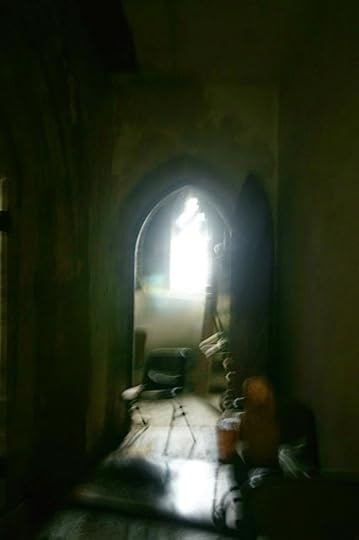 Last night, 11 o'clock-ish, my hair flat, my eyes slightly swollen, my red and white striped socks in grotesque visual combat with my too-tight but also floppy-collared top, I read this story by Pamela Paul in the New York Times. You'll get the gist from the title, perhaps: "She Sounds Smart, but Look at Her Hair!" If you need more, I share this paragraph below—an email Paul received following her seemingly successful (televised) moderation of a book-fair panel in Miami.
Last night, 11 o'clock-ish, my hair flat, my eyes slightly swollen, my red and white striped socks in grotesque visual combat with my too-tight but also floppy-collared top, I read this story by Pamela Paul in the New York Times. You'll get the gist from the title, perhaps: "She Sounds Smart, but Look at Her Hair!" If you need more, I share this paragraph below—an email Paul received following her seemingly successful (televised) moderation of a book-fair panel in Miami.“Had the unfortunate experience of seeing you on Miami Dade College video tossing your head around and continuously pushing the hair out of your face. What the hell is the matter with you? Why wear hair that covers your eye? You are an insult to women.”Paul's piece goes on to feature a handful of other women (Lori Gottlieb, Rebecca Skloot, Bridget Todd) who spend time in the glare of the media sun talking real issues. Women who, after adding something to the intellectual exchange, are barraged later on by inane commentary. Hair. Baggy eyes. A twice-worn purple sweater. The works.
My first thought (and I have been having this thought a lot lately): Glad I am not famous or TV-worthy. Indeed, except for those few days after a stylist has blown some sense into my tresses, I am not even hair-fit for the gym. I've lost friends over the wilderness of the stuff that sprouts from my head. I've endured the exasperation of a colleague who, while perfectly balanced on a stool in a swanky bar, implored me to find a way to fix it.
I have tried. I cannot. Imagine what the anonymous, peering-in-from-their-living-room crowds would say about me were I equipped to endure the media glare in an attempt to say something that mattered.
My second thought (and this should have been my first): Why does it give so many people so much pleasure to be unkind, inconsiderate, ruthlessly shaming? What sports zone are we living in? Why have so many grown so vigorously immune to seeing the bigger picture, and of exercising compassion?
My third thought (and this follows on the heels of my compassion post) is this: What would happen if we all agreed to use our social media channels—our blogs, our Facebook walls, our Twitter, our LinkedIn—for unadulterated good? I know it's a tall order. Heck. There are times when I want to shout, and sometimes do. But what if, for this week ahead, starting now, we set aside our inner mean and only wrote kindly of others (or, as our mothers taught us, held our tongues)?
I'm going to give it a shot. Perhaps you'll join me.
And if you want to join me, pass it on.




Published on March 28, 2015 07:17
March 27, 2015
the sweetest thing (from Tamra Tuller)
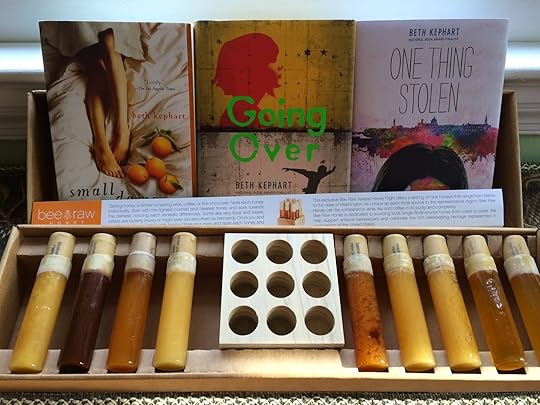 Those of you who thought I could not possibly get any older were wrong.
Those of you who thought I could not possibly get any older were wrong.Another birthday nears.
But oh how sweet has sweet Tamra Tuller made these days of near senescence.
Tamra, I've never seen anything like this. It's a magnificent idea, perfectly packaged.
And together we have built three very pretty books.
Thank you for the years, the friendship, the stories. Honey. That's just right.




Published on March 27, 2015 14:06
after being in the company of the rock stars of YA, I have a dream
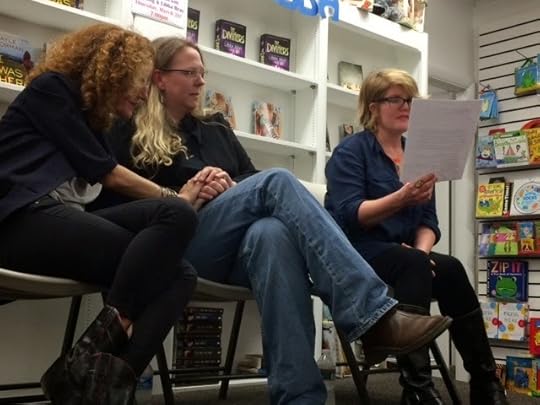 Above? That's Libba Bray reading from her forthcoming novel (Lair of Dreams, due out in August) at Children's Book World in Haverford, PA—a scary little ditty that has Amy Sarig King and Gayle Forman shaking in their respective (albeit from opposing sides of the fashion world) boots.
Above? That's Libba Bray reading from her forthcoming novel (Lair of Dreams, due out in August) at Children's Book World in Haverford, PA—a scary little ditty that has Amy Sarig King and Gayle Forman shaking in their respective (albeit from opposing sides of the fashion world) boots. Before them sit many of my neighborhood's finest writers. Also Sister Kim and her Little Flower students. Also bloggers and readers and enthusiasts and at least one bookseller from down the road and shall we go no further before we mention Heather Hebert, who makes it all happen, and with enthusiasm, and while I am at this, because heck, why not, can we locals all just pause for a minute and welcome Margo Rabb to our neighborhood, because she's here now, newly arrived from Austin, with her second YA novel (Kissing in America) due out in May.
(Seems like I might be reading with Margo and two other fabs from Round Here soon, but more on that to come.)
What a performance these three gave—Amy and Libba gamely (respectively) playing the parts of a stoner and a slick boy in a choral reading from Gayle's new bestselling book, I Was Here. Amy giving a thrilling preview of I Crawl Through It. Libba forcing everyone else into scare mode, then zapping the conversation with four parts hysterical ad lib and one part Barbara Walters. And then plenty of talk about the F word, by which I mean (of course) Feminism.
The doors were open at Children's Book World, to dispel all that animal heat. The skies were ripped apart with rain. I headed home among storm-imperiled drivers and then I fell asleep. At which point I dreamed I was still with the gang, only we had moved onto a Friendly's Restaurant (note: Friendly's, I lie not) and we were having high-calorie ice cream and nobody would speak to me. My offense, in my dream, was that I been me—asking too much, pressing too hard.
I woke just after I'd leaned over somebody's shoulder and read the texts that were circulating about me.
"Beth Kephart," they said, "is so annoying."




Published on March 27, 2015 04:14
March 26, 2015
come and get some LOVE
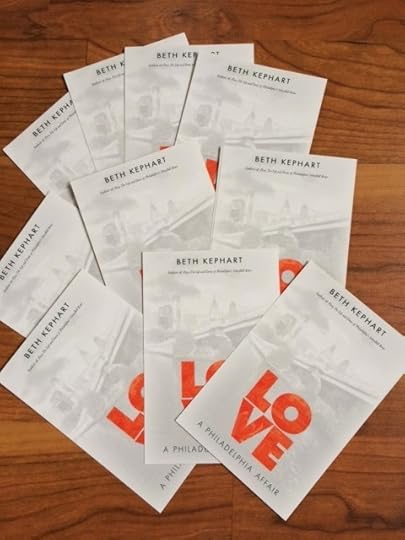 Or:
LOVE: A Philadelphia Affair.
Coming soon.
Or:
LOVE: A Philadelphia Affair.
Coming soon.(With thanks to Temple University Press, and special thanks to Ann-Marie Anderson)




Published on March 26, 2015 11:52



